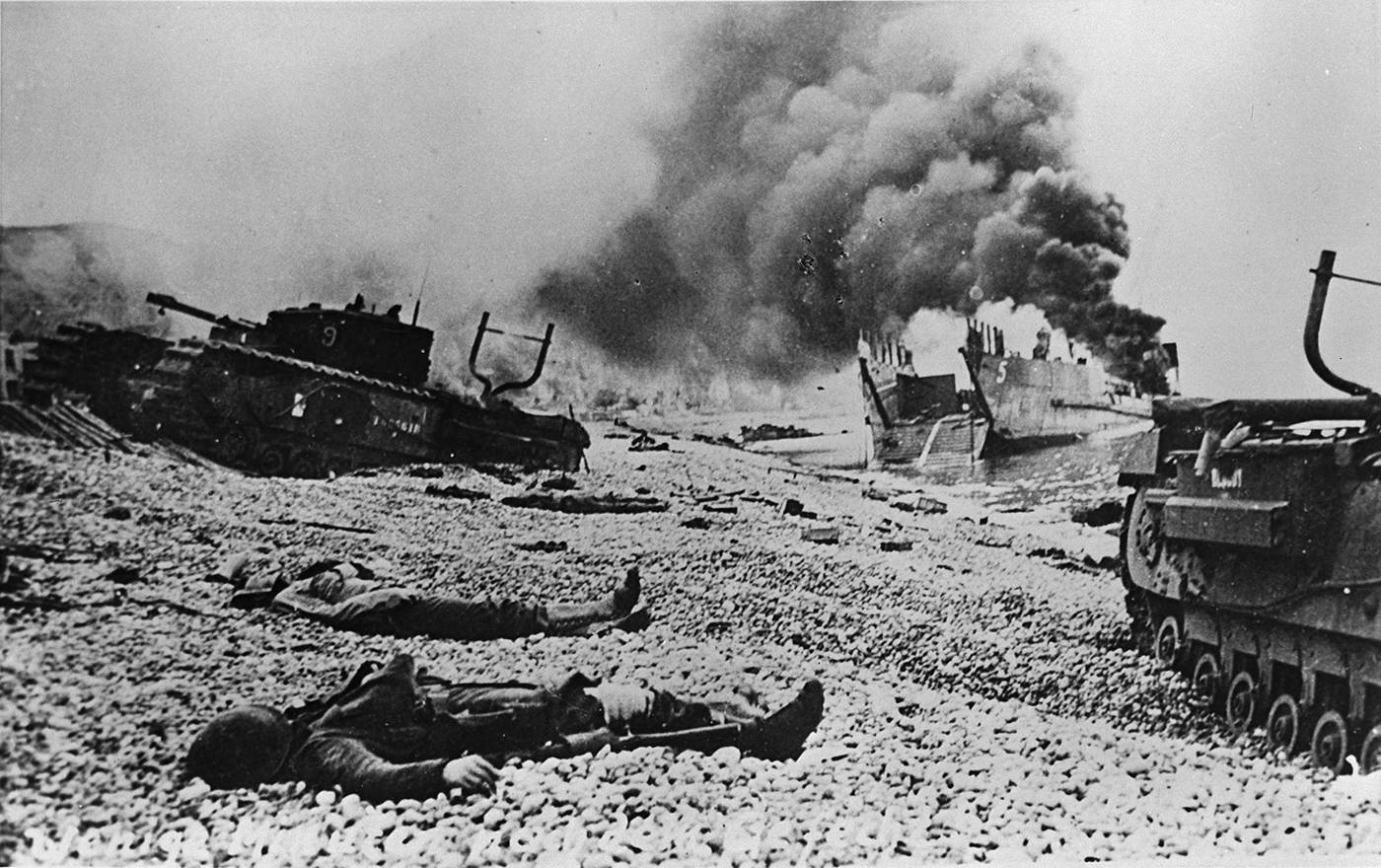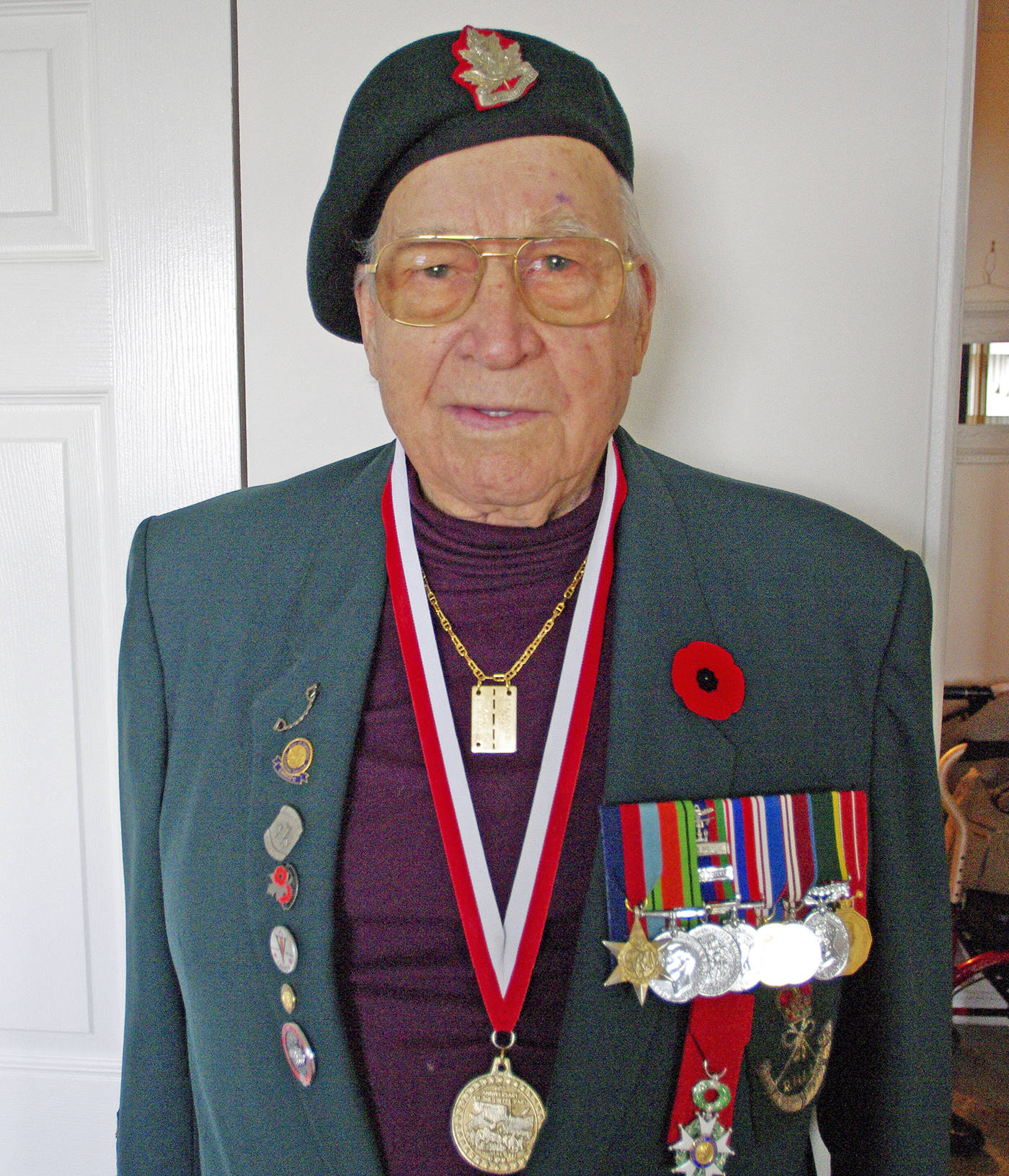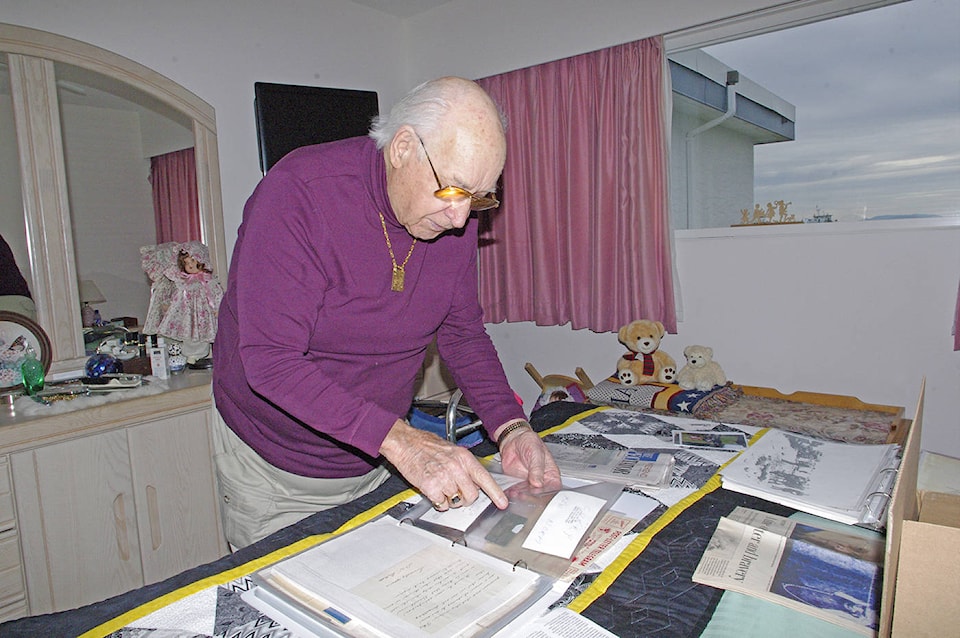It’s easy to take for granted the lifestyle we live in Canada today, forgetting the sacrifices so many people made on so many fronts through history, in order for us to get so far. During November, we pause to try to acknowledge some of those sacrifices at Remembrance Day ceremonies across the country.
Today, on November 10, the day before Remembrance Day, the News Review explores a couple lives on the Saanich Peninsula — people who served Canada in times of war — what’s often left behind after conflict, and some of the monuments we create to honour the men and women who gave their lives in that service.
At 95, Sidney resident Kenneth Curry knows he’s almost the last of his ilk. He grew up in Stoney Creek, outside of Hamilton, Ontario and had joined the Royal Hamilton Light Infantry (RHLI), a reserve unit, when he was 15 years old.
“I had to lie about my age,” Curry smiled, adding someone had to be 16 to join. “I was just a boy soldier.”
At 17 years of age in 1939, Curry was still with the RHLI when the Second World War broke out. Like many others in his regiment, Curry signed up right away — but it wasn’t without a fight of it own. Because of his age, he was told he’d have to stay behind — or get his mother to sign her approval. He said she didn’t want him to go, but he cried and argued that he’d be going soon anyway, once his next birthday came around. Plus, he’d rather go with his buddies, the men he’d trained with for years.
“I wouldn’t have wished for there to be a war,” he said, “but it happened and I was a soldier. It was my job.”
His mother relented and he was soon on his way with the RHLI to England. Had he known that he’d spend almost three years in a German prisoner of war camp, he might have changed his mind.
Curry remembers training for two years in England and by the time the call came for his unit to go to the front lines, he was trained as a commando and part of a mortar team.
That call came on August 19, 1942. Curry said they were loaded aboard ships and once they were under way, were told they were going to a small beach in France at the town of Dieppe.
The name ‘Dieppe’ instills a bit of dread in any military historian. On that day in 1942, troops mainly from Canada but with others from Britain and the United States, made a beach landing and frontal assault on the town, seeking a beachhead for the Allied forces. It was a disaster, with 3,367 men — including 2,752 Canadians — either dead on the beach or taken prisoner — despite orders to evacuate, ending the failed raid. Only 4,963 men had taken part in the raid.
Curry found himself in a rain of machine gun bullets, fired out of the windows of the hotels overlooking the beach. His memories of the day are still vivid: men dying around him, tanks shot up and the cried of the wounded. His mortar team was immediately pinned down on the beach as soon as they got off the landing craft. He said they managed to get their weapon set up and could fire off a few rounds.
A tank was hit and disabled near them, which Curry said protected their left flank.
“Without that tank, we would have been in the open.”
He recalls a sergeant telling them they needed to move but almost as soon as the man had started, he was shot. Curry said he rushed to him and managed to bandage his knee, before being forced back. He would find out only much later that the sergeant had been killed in the gunfire.
“I regret not being able to get him away from there,” Curry said. “It was hell. It was really just … hell.”
With so much gunfire around them, Curry said his crew was worried a round might set off all the mortar bombs they had in a cart. So, he said they fired them all into a hotel. The battle raged four hours and then, close to noon, Curry said the order was given to withdraw. Landing craft moved back in under smoke screens and the wounded were evacuated first. Curry said the shelling kept coming from the German army, and boats were sunk and more people killed.
He managed to get onto a boat, but it was hit and began to sink. He had to swim for his life, diving under water to escape the bullets — one of which grazed his back. But he hadn’t noticed it. He swam under water and the tide eventually took him further down the beach and he washed up on shore at the base of some cliffs. He’d shed his uniform and pistol to swim, and only had on his boxer shorts. He said he ate a chocolate ration he had, and made for an opening he had seen in the cliffs, thinking he might be able to reach the French lines. The only thing he found, were more Germans, who caught him and brought him to where they were holding other Allied soldiers.
Curry suddenly found himself a prisoner of war.
He and others were taken to a nearby factory where the Germans were keeping the prisoners. In a stroke of good fortune, Curry said he found his brother, Norman, also being held there. He was unharmed and they cried as they hugged, collapsing in exhaustion.
That began their close to three years as POWs in Germany. They were eventually transported by train to a camp called Stalag Ville B. They were routinely beaten, manacled, malnourished, questioned and worse. But Curry said they kept their spirits alive with escape committees, and by writing letters home to family. It was in writing those letters — many of which he still has — that he learned his mother had been told he was killed in action and that Norman was missing. The telegraph he has, which his mother kept, is terse. It states in a single line that Ken was killed and Norman was missing, followed by “Sorry.”
“That sent my mother to the hospital.”
Curry’s memories of that time are clear and he recalls as the Germans began to lose the war, they were marched out of the camp towards Hanover, Germany, as Russian forces approached. His group of POWs managed to survive as the Germans ran off and he and some buddies from the camp eventually met up with American soldiers. They were flown to Belgium to be reunited with other Canadians, and then flown to England, were he was hospitalized for malnourishment.
Curry stayed in the military, despite his harrowing time at Dieppe and as a POW. He returned to the RHLI regiment, later transferring to a unit of dragoons and then to the Argyle Southern Highlanders. He would seek his commission as an officer and come to command a cadet corps, before he retired as a major.
He moved to Sidney 20 years ago, having met his late wife, who had also served her country during the Second World War. She would later die and Curry lives today in an apartment overlooking the Salish Sea with his partner, Pat.
Curry said that today, he is one of only two members of the RHLI who took part in the raid on Dieppe, who are still alive. The other man is 97. Because of that, he is very aware of the role he played in that war, in in keeping the memory of those who fought and died there, alive in the minds of Canadians.
editor@peninsulanewsreview.com





